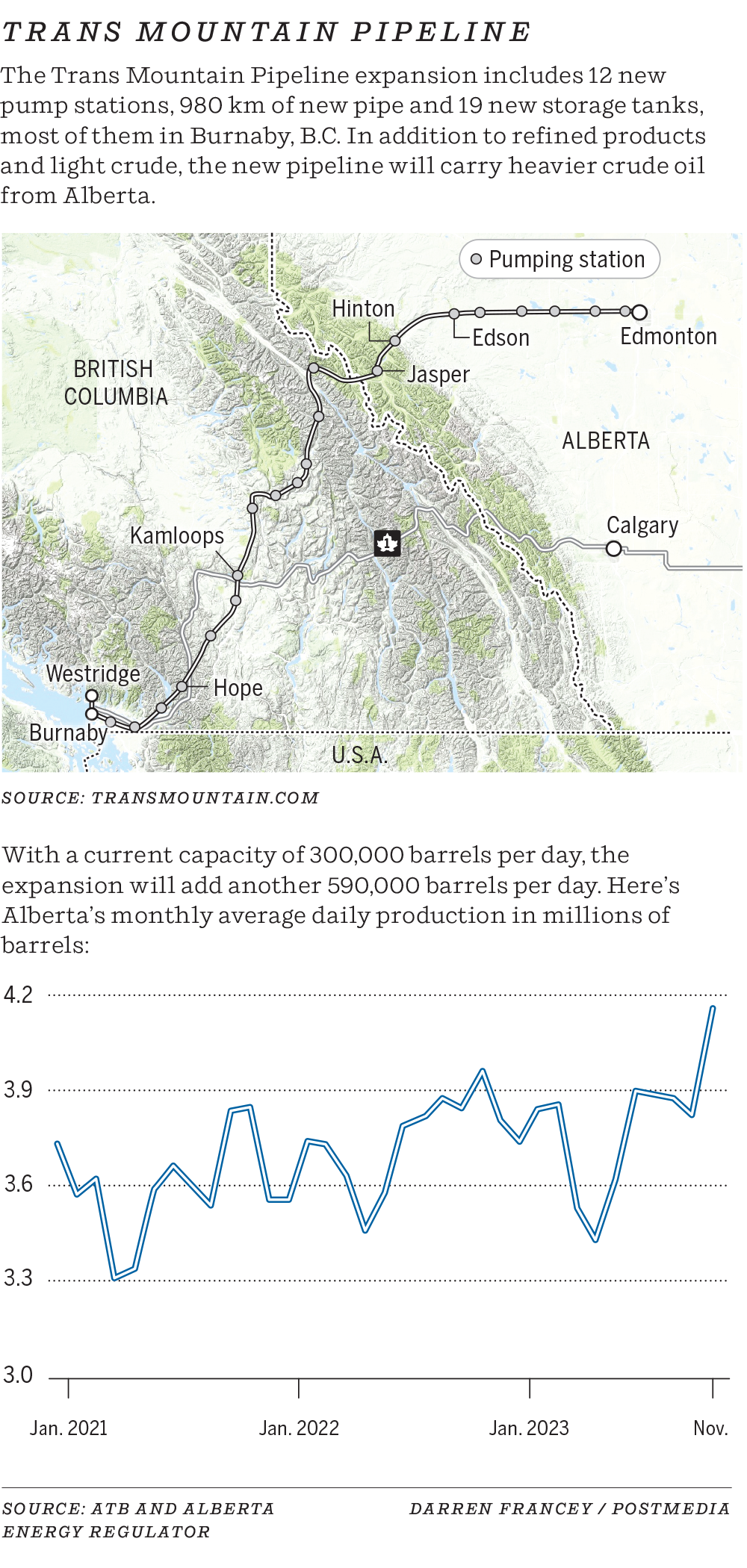
[ad_1]
Facing transportation bottlenecks — and a divisive pipeline debate — for years, the Canadian oil industry is now eagerly awaiting the startup of the Trans Mountain pipeline expansion.
Yet, as construction on the $30.9-billion project draws to a close and it’s expected to begin commercial operations next quarter, analysts and industry leaders anticipate it won’t be too long before the pipeline — along with other oil export lines in Western Canada — begin to fill up.
And then, the persistent issue of insufficient transportation capacity could rear its head, once again.
“The supply is coming, and in very short order Western Canada will probably be north of 90 per cent (pipeline) utilization rate again,” said Kevin Birn, a vice-president with S&P Global Commodity Insights.
“In the long term, we still see Western Canada putting a lot of pressure on its takeaway system . . . We see it filling up progressively over the next 18 to 24 months. By the end of 2025, the system is looking pretty full.”
On Friday, Calgary-based Enbridge reported that its Mainline pipeline system transported an average of 3.2 million barrels per day (bpd) during the fourth quarter, an all-time high.
Even with the Trans Mountain expansion coming online this year, the Mainline system is expected to ship about three million bpd in 2024.
“The Mainline has been basically full for 75 years. So, it’s a trend that continues,” Colin Gruending, Enbridge’s president of liquids pipelines, told analysts Friday on a conference call.
Western Canadian petroleum producers have grappled with transportation constraints for years amid surging oilsands production.
Since 2010, Alberta’s oil output has risen from nearly two million bpd to an average of 3.8 million bpd last year, a record level. During that time, several large pipeline proposals have failed, including Enbridge’s Northern Gateway development and TC Energy’s Keystone XL.
However, the completion of Enbridge’s Line 3 Replacement Project in 2021 added 370,000 bpd of pipeline capacity out of Western Canada to the United States.
The Trans Mountain expansion (TMX), which was submitted to the federal energy regulator in 2013, will almost triple the existing line’s capacity by 590,000 bpd.
“We are short pipe right now. Once TMX comes on, we will likely be long (with excess) export capacity, probably until that 2026 time frame,” said analyst Nate Heywood of ATB Capital Markets.
“We do think that pipelines will be relatively full by the mid-decade.”
-
 Varcoe: ‘A long time coming’: Trans Mountain pipeline expansion aims to be finished in the coming weeks
Varcoe: ‘A long time coming’: Trans Mountain pipeline expansion aims to be finished in the coming weeks -
 Trans Mountain pipeline to start filling with oil in February
Trans Mountain pipeline to start filling with oil in February -
 Regulator calls out Trans Mountain for ’environmental non-compliance’ in B.C.
Regulator calls out Trans Mountain for ’environmental non-compliance’ in B.C. -
 Trans Mountain pipeline variance request approved by Canada Energy Regulator
Trans Mountain pipeline variance request approved by Canada Energy Regulator
While some industry players thought the startup of TMX would cut into Enbridge’s Mainline volumes with added competition, Gruending noted supply has “structurally and permanently grown” with rising demand in recent years.
In 2023, western Canadian oil supply increased by 150,000 barrels per day, he noted. This year, supply will grow by between 250,000 and 300,000 bpd — with another 200,000 added to the mix next year.
At times in the past decade, a lack of transportation capacity has led to a steep price differential between U.S. benchmark crude and Western Canadian Select heavy oil.
The discount reached as high as US$50 a barrel at one point in 2018 during a period of pipeline constraint.
(Provincial data indicates the price differential last year averaged US$18.65 a barrel.)
“There is no doubt we’re going to need more pipe within this decade,” said Tristan Goodman, president of the Explorers and Producers Association of Canada.
“Demand for oil continues to increase on a global basis, year after year after year.”

While the International Energy Agency has forecast oil demand will peak this decade, it projects global consumption will increase by 1.2 million barrels per day this year, after hitting a record of nearly 102 million bpd in 2023.
Hal Kvisle, former CEO of Trans Canada Pipelines, noted producers in Western Canada have added incremental output in recent years by taking steps to debottleneck oilsands operations, rather than building new greenfield projects.
He expects growth will continue, but doesn’t foresee industry players proposing major new export pipelines, given the hurdles and federal policies facing the sector.
However, there is excess gas pipeline capacity heading east and south that could be converted to move oil, and there’s also the potential to move more oil to the U.S. by train.
“We could easily add one or two million barrels a day (from) the oilsands through new projects, but people aren’t going to kick off those new projects unless they have some comfort around federal policies and some comfort there is going to be pipe to get the oil to market,” said Kvisle.
“I think we will build more pipelines and I think Canadian oilsands production will grow, but I don’t see any of that happening in the next five years — other than the little incremental things.”

Once TMX is completed, total pipeline export capacity in Canada will reach more than 4.8 million bpd, Birn said.
Midstream companies will also continue to find ways to expand their existing systems with smaller-scale initiatives.
“We feel the capacity egress will be fairly balanced . . . but if more is needed, we’ll manage that by optimizing our system,” Enbridge said in a statement.
“We have 200,000 bpd of expansion potential on the Mainline that involves debottlenecking and small-scale capacity additions.”
In the longer run, will the discussion turn back to building new pipelines — during an era of decarbonization and growing climate concerns — or will that debate end with the completion of TMX?
“We will always grow production if the world wants our production . . . The problem for me is that after Trans Mountain, I don’t see how anybody is going to build another pipeline,” said Richard Masson, former CEO of the Alberta Petroleum Marketing Commission.
“The long-term answer is we have to find a balance in how quickly we grow, with how much market access we can get. It’s a big challenge.”
Chris Varcoe is a Calgary Herald columnist.
[ad_2]
You can read more of the news on source




